Dell DTR Laptop Shootout - M1710 vs. E1705
by Jarred Walton on May 30, 2006 1:30 PM EST- Posted in
- Laptops
User Upgrades
Getting a look at the motherboard may be interesting for the hardware geeks, but realistically most people won't be opening up their systems to upgrade the processor. Quite a few areas can be upgraded without going through nearly as much effort, however. Most of the user upgradeable areas can be accessed via the bottom of the laptop.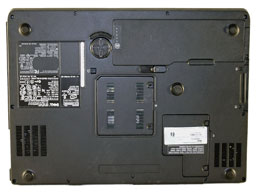 |
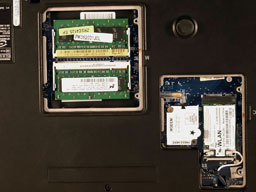 |
| Click to enlarge | |
The most likely - and easiest - upgrade would be to increase the amount of memory in your system. The center cover is secured by two screws and hides access to the two SO-DIMM slots. It's worth mentioning once again that the 945GM/PM chipset only has a 64-bit front side bus, so while it can support dual channel memory, there is little advantage in running dual channel over a single channel - at least if you use DDR2-667 memory. If you're looking for a high-performance laptop, we definitely recommend going with 2GB of memory these days, especially if you're running a dual core processor. However, paying Dell for your memory upgrade may not be the most cost-effective way of getting more RAM. If you're willing to do the upgrade yourself, you might be able to save a few bucks, and just about anyone with a screwdriver should be able to swap out memory modules. The only caveat is that you need to make sure you get Dell compatible RAM, which generally means RAM that strictly adheres to the JEDEC standards (i.e. 5-5-5-15 timings at DDR2-667).
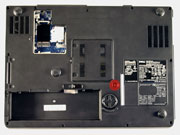 |
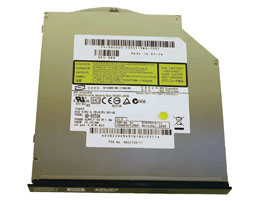 |
| Click to enlarge | |
Next up in terms of simplicity would be an upgrade to your optical drive. On the bottom of the laptop, you remove one screw, insert the screwdriver into the vacated hole, and pry the DVD drive loose. Of course, as long as you get one of the models with a dual layer DVD-RW drive, you're not likely to need to upgrade your optical drive any time soon. Blu-Ray and HD-DVD will both likely become available in laptop drive format in the future, but until that standards war calms down and we can declare a winner, 8X DVD-RW will get the job done.
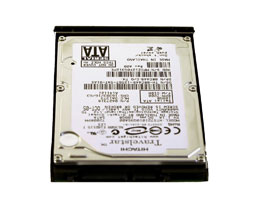 |
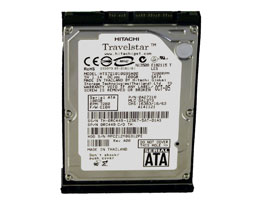 |
| Click to enlarge | |
Upgrading the hard drive is done in a similar manner: remove the two screws and slide out the hard drive cage. Note that these laptops are among the newer models that use 2.5 inch SATA hard drives. You'll probably want to use some drive imaging software to clone your original hard drive as well, in order to keep the Dell system restore utility and partition present. (We'll have the bit more to say on that later.)
 |
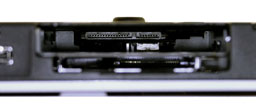 |
| Click to enlarge | |
The last area that you might want to upgrade at some point is the WiFi support. One option is to remove the included mini-PCI card and install an upgraded card. However, not all mini-PCI cards are compatible with all systems, so you'll want to make sure that the card will work in advance. The alternative is to find an upgraded WiFi card that will work in the ExpressCard slot. There are no ExpressCard modules on the market right now, but availability is anticipated late this year. We should also start seeing some faster WiFi offerings hit the market later this year, with 802.11N making an appearance very soon. Going with ExpressCard instead of sticking with PC Card is another interesting compromise; Dell has sacrificed support for a wide variety of current offerings in order to provide future functionality. Long-term, ExpressCard should be the better solution, but whether it will reach its potential during the life of the laptop remains to be seen.










34 Comments
View All Comments
Gary Key - Tuesday, May 30, 2006 - link
Jarred will be reviewing these in the near future.tthiel - Tuesday, May 30, 2006 - link
I've been issued plenty of Dell laptops at the various companies I have worked for and they were all cheap plasticky junk. I've lost track of how many died on me. I was just given a new Thinkpad T43P and it is much better. Very well made, rock solid. So many of the engineers where I work wanted those instead of Dells that they had to restructure the ordering process and images to take care of all the new Thinkpads.JarredWalton - Tuesday, May 30, 2006 - link
I've heard about problems with ThinkPads now that Lenovo has taken over. (I haven't used any personally, so I can't say for sure.) I have also used many of the older Inspiron models, and have been unimpressed. These are definitely in a different league, however -- the cheap plastic case (at least on top) has been replaced by aluminum, for example. The problem is that most businesses don't buy higher end Dell laptops; they go with the more value oriented offerings, and whenever prices cut you can be sure that quality is cut as well.We're hoping to expand our mobile coverage in the future, so this is merely the beginning. As time goes on, we'll have more products that we can directly compare new offerings with. For now, I'm generally impressed with what the E1705 offers. Impressed enough that I recommended one to a family member, after browsing around looking for a suitable equivalent. Getting a large laptop with a 17 inch (or larger) display, 1920x1200 resolution, dual core processor, etc. is pretty difficult right now. Getting one with 2 GB of RAM for $2300 is even more difficult. Not everyone wants a laptop this large, certainly, but for those that do the E1705 is quite good.
jenson - Monday, January 7, 2013 - link
when cheap laptops really got a good shake, with many models looking and behaving a lot more like their costly cousins than in the past.